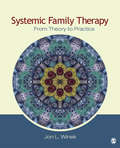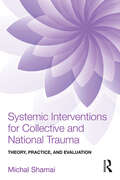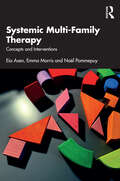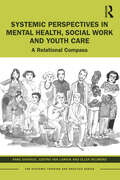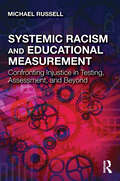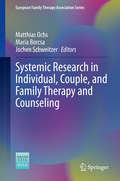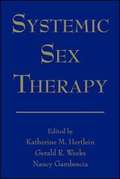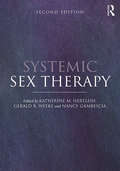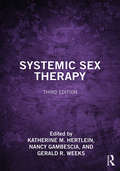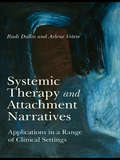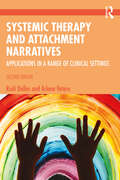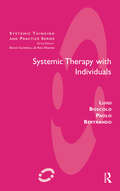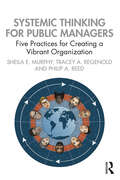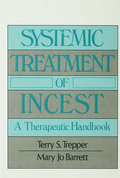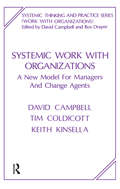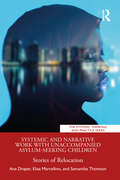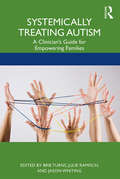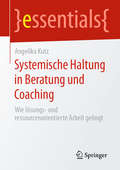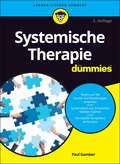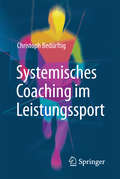- Table View
- List View
Systemic Family Therapy: From Theory to Practice
by Dr Jon L. WinekNo other available text offers such a hands-on approach to marriage and family therapy theory. At the core of Systemic Family Therapy are comprehensive sections devoted to each developmental phase of the family therapy movement. With clear descriptions and session-by-session case examples, the author explores specific approaches within each of these phases. With this pragmatic tenor, students will gain a clear and in-depth understanding of how family theory concepts relate to practice–as well as ways those concepts interact with each other. Key Features Uses specific examples and session-by-session case studies to illustrate how theoretical construct actually work in practice Outlines the shifts in thinking of the family therapy field–from modern to postmodern Uses rich graphic representations and straightforward tables to illustrate key theoretical concepts Incorporates compelling questions and learning exercises that will lead to dynamic class discussionsIntended Audience A refreshing departure from traditional instruction of family therapy theory, this core textbook is an excellent resource for upper-level undergraduate and graduate students of family therapy, counseling, social work, and family studies.
Systemic Interventions for Collective and National Trauma: Theory, Practice, and Evaluation
by Michal ShamaiSystemic Interventions for Collective and National Trauma explains the theoretical basis for understanding collective and national trauma through the concept of systems theory, and gives ways of implementing systems theory in interventions at the micro, mezzo, and macro levels. Particular attention is given to the use of socio-political and cultural aspects of interventions with victims, as well as to the ethical codes that social workers and other mental health professionals need to integrate in their work with collective/national trauma. Separated into two distinct parts on theory and practice, this volume is appropriate for practitioners as well as students in advanced courses.
Systemic Multi-Family Therapy: Concepts and Interventions
by Eia Asen Emma Morris Noël PommepuyThis book provides a pragmatic guide to multi-family therapy (MFT), as employed in a variety of different settings: health, social care and education. Bringing six to eight families together to work on similar issues in MFT has become an increasingly successful intervention that encourages service user-participation and moves towards a more patient- and family-centred care. This text describes the concepts, therapeutic stances, interventions and techniques of MFT, bringing together all the major recent developments in the field. Specific topics covered include how to engage families in working together with up to eight families with similar issues and problems, how to set up and conduct multi-family groups and how to evaluate and develop interventions. The book covers working with and across diverse cultures, conditions and problems and includes a chapter on different MFT exercises, activities and games. Systemic Multi-Family Therapy is written for a range of practitioners, including psychotherapists, psychologists, psychiatrists, group therapists and family therapists, and will also be relevant for most professionals working in social care and schools.
Systemic Perspectives in Mental Health, Social Work and Youth Care: A Relational Compass (The Systemic Thinking and Practice Series)
by Justine van Lawick Anke Savenije Ellen ReijmersSystemic Perspectives in Mental Health, Social Work and Youth Care describes the theoretical foundations of a systemic framework, or ‘systemic lens’, and how the counsellor, therapist, social worker or other health professional can apply these ground principles in therapeutic meetings with clients. The book presents a wide variety of perspectives and interventions, multiple examples, and practical methods, applicable to professionals with a range of experience. A case study covering a diverse family of three generations is presented throughout the book to clearly illustrate systemic perspectives, concepts, and practices. This accessible book will inform and enhance the therapist’s practice and conversations with individuals, couples, parents, groups or networks, even in the presence of psychopathology, multi-stressors or complex networks. This highly readable guide will be essential reading for systemic practitioners of all backgrounds, as well as professionals looking to understand systemic approaches, and for those working in social work, youth care or mental health who want to enhance their current practice.
Systemic Racism and Educational Measurement: Confronting Injustice in Testing, Assessment, and Beyond
by Michael RussellSystemic Racism and Educational Measurement provides a theoretical and historical reckoning with racism and oppression produced through educational measurement and research methodology. As scholars and professionals in the testing, measurement, and assessment of human learning and performance work to exorcise race sciences, white supremacy, and other injustices from the field’s research and practice, new insights are needed into their root causes. This book is the first to posit that the theory of the White Racial Frame was and continues to be applied to the foundations, process, dissemination, and use of educational measurement, leading to instruments, findings, and decisions that perpetuate the racialized social structure of our nation. Even among well-meaning stakeholders who aim to improve humanity and address inequities, the White Racial Frame shapes the field’s research questions, the methods utilized, the data valued, the interpretations made, and the language used throughout. Students and scholars of educational measurement, testing, and psychometrics will find invaluable clarifications of terminology, concepts, and theories integral to understanding systemic barriers in the field; explications of educational measurement’s core purposes and its influence by the White Racial Frame; and a series of alternate frames, theories, and epistemologies intended to guide educational measurement toward anti-racism and increased fairness.
Systemic Racism in the United States: Scaffolding As Social Construction
by Robbie W. C. Tourse Johnnie Hamilton-Mason Nancy J. Wewiorski"Tourse, Hamilton-Mason, and Wewiorski discuss major concepts that help explicate the systemic nature of institutionalized racism in the U.S. – with a focus on social construction, oppression, scaffolding, and institutional web – providing insight into racist thought and behavior that construct and mark people of color as 'a problem.' […] I highly recommend this book for those who are engaged in working to combat domination and racism at the local, national, and global levels."-Gary Bailey, DHL, MSW, ACSW, Professor of Practice, Director of Urban Leadership Program, Simmons College School of Social WorkThis important volume provides a powerful overview of racism in the United States: what it is, how it works, and the social, cultural, and institutional structures that have evolved to keep it in place. It dissects the rise of legalized discrimination against four major racial groups (First Nations, Africans, Mexicans, and Chinese) and its perpetuation as it affects these groups and new immigrants today. The book’s scaffolding framework—which takes in institutions from the government to our educational systems—explains why racism remains in place despite waves of social change. At the same time, authors describe social justice responses being used to erode racism in its most familiar forms, and at its roots. This timely resource: Examines the sociology of discrimination as a constant in daily life.Traces the history of the legalization of racism in the United States.Locates key manifestations of racism in the American psyche.Links racism to other forms of discrimination.Identifies the interlocking components of institutionalized racism.Offers contemporary examples of resistance to racism.A forceful synthesis of history and social theory, Systemic Racism in the United States is vital reading for practitioners and other professionals in fields related to human rights, social policy, and psychology. And as a classroom text, it challenges its readers to deepen their understanding of both historical process and current developments.
Systemic Research in Individual, Couple, and Family Therapy and Counseling (European Family Therapy Association Series)
by Maria Borcsa Jochen Schweitzer Matthias OchsThis book examines systemic family therapy research, addressing key topics across the interrelated disciplines of psychotherapy, social work, and counseling. Drawing from contributions at the 2017 International Systemic Research Conference in Heidelberg, it includes both quantitative and qualitative research perspectives and outlines a wide array of approaches, using systems theory and constructivist epistemology. In addition, the book focuses on innovative paradigms, research strategies, and methods, seeking to bridge the gap between research and practice in the field of systemic family therapy. Finally, it provides guidance on submitting and maximizing the likelihood of research paper acceptance to leading family therapy journals. Topics featured in this book include:Effectiveness of research-informed systemic therapy.Mindfulness and compassion-based interventions in relational contexts.Use of SCORE (Systemic Clinical Outcome and Routine Evaluation) as an indicator of family functioning in Europe.Systemic approaches for working with couples with high conflict behaviors.Therapeutic-Factor-Oriented skill building in systemic counseling.Importance of client feedback in development of professional knowledge base. Systemic Research in Individual, Couple, and Family Therapy and Counseling is a must-have resource for researchers, professors, and graduate students in family therapy, clinical psychology, general practice/family medicine, and social work as well as all interrelated psychology and medical disciplines.
Systemic Sex Therapy
by Gerald R. Weeks Katherine Milew Hertlein Gerald Weeks Nancy Gambescia Katherine M. HertleinSystemic Sex Therapyserves as an introduction to the field of sex therapy from a systems perspective. It is an excellent resource for graduate students in marriage and family therapy programs or students and professionals who want a truly fresh perspective on sex therapy. This approach moves beyond traditional behavioral approaches to incorporate individual, couple, and intergenerational factors in etiology and treatment. Unlike current books on the market that are outdated, too advanced, simplistic, unfocused, or too diffuse in content, Systemic Sex Therapyis comprehensive, concise, highly focused on treatment, user-friendly, and contains features not found in other sex therapy texts, such as a systemic/behavioral focus, clinical innovation, and a greater focus on implementation rather than competing works.
Systemic Sex Therapy
by Gerald R. Weeks Nancy Gambescia Katherine M. HertleinThis comprehensive textbook, intended for graduate students in couple and family therapy programs as well as for clinicians of diverse orientations, offers descriptive discussions of sex therapy based on the Intersystem Approach, as developed by Gerald Weeks. The Intersystem Approach considers the biology, psychology, couple dyad, family-of-origin, and larger contextual factors of any sexual disorder or issue. It is grounded in systems theory and represents a new understanding of human sexuality and sexual problems. Appropriate for anyone who wants to progress to a more comprehensive and integrative understanding of sexual dysfunctions, this text will teach the reader how to treat the couple, rather than the individual. Now in a second edition, Systemic Sex Therapy presents 12 updated chapters and two new chapters, bringing the material up-to-date with the DSM-5. Each chapter examines the definition and description of a disorder, its etiology, assessment, treatment, research, and future directions. Experts in the field discuss issues ranging from pharmacology, sexual compulsivity, therapy with lesbian and gay couples, to chapters on male and female lack of desire. A standard text in the field, Systemic Sex Therapy integrates couple and sex therapy to inform the treatment of sexual problems, and to give beginning and experienced clinicians the abilities and confidence they need to produce viable change in their patients’ lives.
Systemic Sex Therapy
by Gerald R. Weeks Nancy Gambescia Katherine M. HertleinSystemic Sex Therapy, 3rd edition integrates couple and sex therapy to inform the treatment of sexual problems and to give beginning clinicians the abilities and confidence they need to produce change in their patients’ lives. Grounded in the Intersystem Approach, the book considers the biology, psychology, couple dyad, family-of-origin, and larger contextual factors of any sexual disorder or issue. Each chapter examines the definition and description of a sexual disorder or issue, its etiology, assessment, treatment, research, and future directions. This thoroughly revised edition presents 18 updated chapters consistent with the DSM-5 and features new content on sexuality and aging, infidelity, sexual interest/arousal disorder, disability, and kink/BDSM. Experts in the field discuss all the major sexual dysfunctions along with new chapters on culture, technology, and their interplay with sexual functioning. An essential text in the field, Systemic Sex Therapy sets out a conceptual framework for graduate students in couple and family therapy programs looking to develop a comprehensive, integrative understanding of sexual issues.
Systemic Therapy and Attachment Narratives: Applications in a Range of Clinical Settings
by Rudi Dallos Arlene VetereProfessional interest in the clinical applications of attachment theory continues to grow and evolve, and at the same time narrative approaches are also gaining ground. This book explores how attachment-based ideas can be used in clinical practice by offering a practical and sophisticated exposition of clinical approaches. Bringing together three main systems of thought and psychotherapeutic practice - systemic theory, attachment theory and narrative theory - practitioners are shown how to use these ideas in their work through the integrated approach of ‘attachment narrative therapy’. Using clinical examples, the authors provide guidance on how to use attachment narrative therapy in different clinical contexts and with various client groups, including working with: addictions: alcohol dependency and eating distress loss and grief trauma and dissociation love and sexuality: applications with couples. Systemic Therapy and Attachment Narratives provides practical guidance for a range of mental health professionals including family therapists, child, adolescent and adult psychotherapists, clinical psychologists and social workers, enabling them to apply this approach in a range of contexts.
Systemic Therapy and Attachment Narratives: Applications in a Range of Clinical Settings
by Rudi Dallos Arlene VetereSystemic Therapy and Attachment Narratives explores how attachment-based ideas can be used in clinical practice by offering a practical and sophisticated exposition of clinical approaches. This new edition offers an updated overview of the integrations of attachment, systemic and narrative theory, and practice incorporating key developments in developmental trauma, intergenerational trauma and neuroscience of the emotional brain. It shows how early emotional experiences set the tone of the narratives we develop about our lives and how these in turn shape our emotional connections. This edition is more oriented towards activities and features more visual representations of problematic patterns of interaction, showing their significance for the family members. It also uses clinical examples to provide guidance on using attachment narrative therapy in different clinical contexts and with various client groups. The book provides practical guidance for a range of mental health professionals including family therapists, child, adolescent and adult psychotherapists, clinical psychologists and social workers, enabling them to apply this approach in a range of contexts.
Systemic Therapy with Individuals (The Systemic Thinking and Practice Series)
by Paolo BertrandoThe authors describe the work they are doing with individual clients in Milan. Locating themselves clearly within the tradition of the Milan approach and more recent social constructionist and narrative influences, and articulating continually a broad systemic framework emphasizing meaning problems in context and relationship, they introduce a range of ideas taken from psychoanalysis, strategic therapy, Gestalt therapy and narrative work. They describe the therapy as Brief/Long-term therapy and introduce new interviewing techniques, such as connecting the past, present and future in a way that releases clients and helps them construct new narratives for the future; inviting the patient to speak to the therapist as an absent family member; and working with the client to monitor their own therapy. The book is written with a freshness that suggests the authors are describing "work in progress", and the reader is privy to the authors' own thoughts and reactions as they comment on the process of their therapy cases. This is a demystifying book, for it allows the reader to understand why one particular technique was preferred over another.
Systemic Thinking for Public Managers: Five Practices for Creating a Vibrant Organization
by Philip Reed Sheila Murphy Tracey RegenoldOffering a pathway to vibrant organizations, this book integrates systems thinking, critical thinking, and design thinking, and provides the tools needed to proactively apply them in the social systems where we live and work. Systemic thinking—the combination of systems thinking, critical systems thinking, and design thinking—provides a way of addressing the complexity of problems faced by public sector managers. Far too often systemic thinking has been discussed theoretically rather than practically. This book changes that, enabling public sector managers and leaders to connect staff, partners, and stakeholders in the pursuit of thoughtfully designed and responsive service. Clearly written and designed to be put to immediate use on the job, each chapter provides a discussion of one specific practice. Included are guiding principles, a case study, relevant practical tools, and suggestions of for additional practice and reading.Using this book, managers of social systems such as public welfare, healthcare, public schools and libraries, housing and community development, and students of public administration will gain a deeper understanding of organizational systems and design, and a new toolkit to fortify their own organizations.
Systemic Treatment Of Incest: A Therapeutic Handbook (Psychosocial Stress Series #No. 15)
by Mary Jo Barrett Terry TrepperSystemic Treatment of Incest is the first book to take as its primary focus the treatment of incest families. The authors, who have spent a total of 25 years working with incest families, believe that therapy can succeed in halting the abuse without dissolving the family unit. The volume’s three sections are based on the authors’ three stages of therapy: creating a context for change; challenging behaviors, expanding alternatives; and consolidation. First published in 1990. Routledge is an imprint of Taylor & Francis, an informa company.
Systemic Work with Organizations: A New Model for Managers and Change Agents (The Systemic Thinking and Practice Series)
by David Campbell Tim Coldicott Keith KinsellaSystemic Work with Organizations explores a powerful new perspective on the challenges faced by managers and consultants who work in large organizations. Building on principles and methods originally developed in the family arena, the authors show how an emphasis on connection, context and communication can help managers and others involved in change, deal with issues of identity, leadership, and learning faced by staff in today's complex work environment.The main thesis is that one way cause and effect thinking and a central focus on the role of the individual, is no longer sufficient. Managers and change agents now need to make use of the insights and interventions offered by a systemic perspective that highlights the roles played by circularity and reflexivity in how people construct shared meaning in human systems.
Systemic and Narrative Work with Unaccompanied Asylum-Seeking Children: Stories of Relocation (The Systemic Thinking and Practice Series)
by Ana Draper Elisa Marcellino Samantha ThomsonSystemic and Narrative Work with Unaccompanied Asylum-Seeking Children: Stories of Relocation provides a contextualised, research-based understanding of how to enhance and support the emotional health and well-being of unaccompanied asylum-seeking children.The framework presented in this book is an innovative intervention that enhances the well-being of children who have experienced trauma by improving the therapeutic abilities for all who support and care for them. This book presents the evidence base for this new systemic and narrative trauma-informed framework of care, creates a wider understanding of working with trauma responses in unaccompanied asylum-seeking children and offers coherence for practitioners wanting to use this approach. The authors provide a physiological view, as well as identify embodied aspects of trauma experience, and describe a narrative approach developed from a clinical understanding of trauma, as well as presenting the words of children who took part in the project. Creating a common multi-disciplinary language, this approach can be used to improve coherence, coordination, and excellence within the whole system.This book is essential reading for all practitioners working with unaccompanied asylum-seeking children. It will also be of interest to students and trainees of social work and other mental health disciplines, as well as other professionals seeking to understand the needs of this group.
Systemically Treating Autism: A Clinician’s Guide for Empowering Families
by Jason B. Whiting Brie Turns Julie RamischSystemically Treating Autism provides a unique resource for family therapists and other mental health professionals who want to increase their understanding of families with children with autism spectrum disorder (ASD). Through a combination of research, practical interventions, and case vignettes, this text covers the diagnosis of ASD, how ASD impacts the family, systemic theories that can be used when treating families with children with ASD, spirituality and cultural dynamics, and collaboration with other professionals. Providing a systemic framework for conceptualizing a diagnosis that is typically discussed from an individual perspective, this book guides mental health clinicians toward a better understanding of how they can help the entire family unit.
Systemik für ganzheitliche Resilienz im permanenten Wandel der agilen VUCA/BANI-Welt: Wieso der systemische Ansatz so heil- und wirksam ist für die nötigen Anpassungen in der digitalen VUCA/BANI- und KI-Welt (essentials)
by Angelika KutzAngelika Kutz LL.M. beschreibt, wieso die Systemik mit der Systemische Haltung so heil- und wirksam ist für die nötigen Anpassungen in der digitalen VUCA/BANI- und KI-Welt und zeigt Möglichkeiten und Wege auf, den rasanten Veränderungen spielerisch-neugierig und resilient zu begegnen.
Systemische Haltung in Beratung und Coaching: Wie lösungs- und ressourcenorientierte Arbeit gelingt (essentials)
by Angelika KutzIn diesem essential wird gezeigt, dass das Handlungsportfolio der Systemik eine wunderbare Grundlage bietet, um Klienten – oder auch ein Klienten-System – bestmöglich dabei zu unterstützen, Veränderungsprozesse (Change) einzuleiten und zu gestalten und für das Klientensystem passende Lösungen zu erarbeiten. Die systemische Haltung ist zudem erlernbar, ein heilsamer Wegbegleiter in allen Lebenslagen und stellt einen kontinuierlichen Reifungsprozess dar.
Systemische Psychotherapie: Lehrbuch für Studium und Weiterbildung (Psychotherapie: Studium & Ausbildung)
by Astrid Beermann Björn Enno HermansDieses Lehrbuch für das Psychotherapiestudium sowie die postgraduale Aus- undWeiterbildung vermittelt praxisnah und didaktisch hochwertig die Grundlagen undAnwendungsformen der Systemischen Psychotherapie im Umgang mit psychischen Störungen.Die Inhalte, die sich mit erkenntnistheoretischen Grundlagen, typischen Vorgehensweisen und Merkmalen sowie Anwendungsbereichen systemischer Therapie vielseitig und vertieft befassen, orientieren sich am Gegenstandskatalog für die schriftlichen Prüfungen nach dem Psychotherapeutengesetz und der Psychotherapie-Richtlinie und werden kompetenzorientiert („Vom Kennen zum Können“) anhand eines multimodalen Lehrbuchkonzepts vermittelt: Lesetexte werden mit digitalen Medieninhalten (z. B. Videos, Audios) ergänzt. Fallbeispiele, praxisbezogene Anregungen, Reflexionsfragen und Übungsangebote zeigen die Praxisnähe, Diskussionen zu einzelnen Aspekten vertiefen das Wissen, veranschaulichen verschiedene Perspektiven der systemischen Sichtweise und regen zum Weiterdenken und zu Diskursen an.
Systemische Strategiearbeit in Organisationen: Strategiekompetenz für Entscheider und Berater (essentials)
by Volker Köhninger Andrea Mikoleit Thorsten VeithMegatrends und Disruptionen verändern die Organisationswelt radikal und erfordern neue Formen der Unternehmenssteuerung. Neben Strategiekompetenz werden die Verantwortungs- und Entscheidungskultur sowie die Lernfähigkeit von und in Organisationen essentielle Faktoren für zukünftigen Erfolg sein. Systemische Strategiearbeit liefert hierfür Anregungen und Konzepte – zur Gestaltung einer modernen Zukunftsarbeit.
Systemische Strukturaufstellungen in Beratung und Management: Das Implizite Und Unbewusste Wissen Für Entscheidungen Aktivieren
by Marlen Gabriele ArnoldDieses Buch bietet fundierte Einblicke in eine faszinierende neue Methode, mit der Systeme erfasst, abgebildet und erprobt werden können. Inhaltlicher Schwerpunkt sind betriebswirtschaftliche und organisationale Faktoren. Die Autorin beschreibt Entscheidungsherausforderungen in den Bereichen Individuum, Organisation und System. Sie zeigt verschiedene Aufstellungsformate für das systemische Arbeiten im Managementkontext. Neben der theoretischen Aufbereitung werden praktische Beispiele auf allen drei Ebenen (Person, Organisation und System) anschaulich dargestellt und visualisiert. Prägnante Bilder der Aufstellungen unterstützen das Verständnis und veranschaulichen, wo konkrete Nutzungspotenziale liegen.
Systemische Therapie für Dummies (Für Dummies)
by Paul GamberMöchten Sie etwas in Ihrem Leben verändern? Ihre Beziehungen zu Familienmitgliedern, Ihrem Partner oder zu Kollegen positiver gestalten, Ihre Ängste oder nagende Eifersucht verlieren, sich von zwanghaften Gewohnheiten befreien oder Ihr Leben wieder ohne zerstörerische Grübeleien genießen? Interessieren Sie sich für eine Psychotherapie, scheuen aber die schmerzhafte Betrachtung alter Wunden? Dann ist dieses Buch das richtige für Sie. Paul Gamber zeigt anhand vieler Bespiele, wie Beziehungen, die Systeme, in denen wir leben, uns formen, stärken, aber auch krank machen können und wie Sie lernen, die Sichtweisen über sich und Ihre Beziehungen zu verändern. Er erklärt, wie die Systemische Therapie auf Ihren Stärken aufbaut, sich Lösungen zuwendet und nicht Problemen, und wie Sie Ihre Kraftquellen wieder erkennen. So können Sie Ihren Blick nach vorn richten und gestärkt dem Alltag begegnen.
Systemisches Coaching im Leistungssport
by Christoph BedürftigAls systemischem Berater und Wettkampfsportler ist es Christoph Bedürftig ein Bedürfnis, seine Erfahrungen aus zahlreichen eigenen Wettkämpfen, die Sorgen eines heranwachsenden Leistungssportlers und die der Eltern mit der mentalen Herausforderung an die Leistungsstärke in einem Werk zu verbinden um den Lesern eine Idee davon zu vermitteln, was neben reinem Training heute mehr denn je zum Training gehört, um Spitzenleistungen im Sport zu erreichen. Immer wieder gilt es zu betonen, dass sich Topsportler zumeist „nur“ mental in ihrer Leistung von der erweiterten Spitze abheben. Sie sind in der Lage, in den entscheidenden Momenten des Wettkampfes eine „Schippe“ drauf zu legen. Und genau diese Eigenschaft kann trainiert und erlernt werden. Mit welchen Methoden soll diese Buch durch Praxistipps, Theorie und Fallbeispiele unter Beweis stellen.
